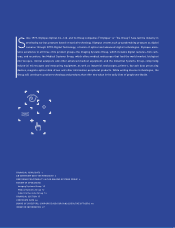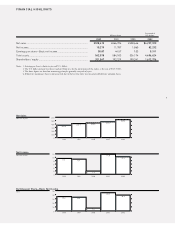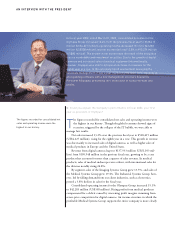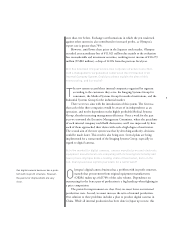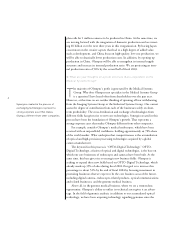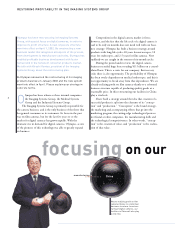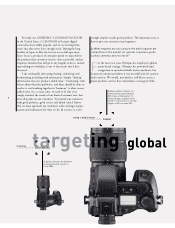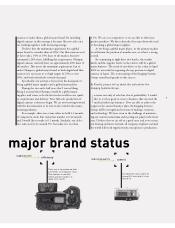Olympus 2002 Annual Report Download - page 9
Download and view the complete annual report
Please find page 9 of the 2002 Olympus annual report below. You can navigate through the pages in the report by either clicking on the pages listed below, or by using the keyword search tool below to find specific information within the annual report.
strengths
increasing speed
improving response
delivering sooner
The production organization
and infrastructure in Japan has
been integrated into Olympus
Opto-Technology Co., Ltd.,
which began operations on
April 1, 2002.
The approximately 200 employ-
ees of Olympus ProMarketing,
Inc., the company responsible
for marketing in Japan, were
integrated into the internal
Imaging Systems Group.
Our CAMEDIA C-2 ZOOM digital
camera has been wildly popu-
lar, and we are hearing from
stores that they never have
enough stock. During the long
holiday the factory was in full
operation.
7
Q: Have any positive effects been realized from the reor-
ganization? Also, does it appear that the newly formed
Imaging Systems Group is going to achieve its goals?
When I circulate among retail and other stores, I am
consistently hearing how much the atmosphere has
improved. Through thoughtful integration of the
organizations and their activities we are moving quickly
toward the goal of turning the loss-making Imaging Systems
Group into a profit-making business.
We are currently working along a strategy that distin-
guishes core business (film cameras, recorders), new core
business (digital cameras) and new business, and with the
synergies created, this strategy will without fail make this
division profitable.
We have already managed positive results in film cam-
eras, one of our core businesses, and recorders have also
become a noteworthy profit-making business. In digital
cameras, one of our new core businesses, we intend to bounce
back with a profit in fiscal 2003. We have made this commit-
ment both within the company and externally, and in our
business plan it states clearly that “we will without fail
achieve” our goal. We have increased the speed not just of
various functions, but that of the entire organizational
structure.
The “conception” will be done in Japan, while our
operations in China will focus on the “production.” This
pairing of “conception” and “production” I refer to as the
“flow cycle.” The flow of product planning up until now has
been to develop, manufacture and then offer to customers. In
the case of consumer goods, however, the main issue has been
the speed of the “flow cycle” as it runs from planning, pro-
duction and manufacture to customer feedback. This is
usually called the “throughput,” but lately it has come to be
referred to as “digital throughput” because of the instanta-
neous way the cycle comes full circle.
The “conception” portion will be pulled together in
Japan, reflecting the feedback received from customers, while
China will handle the “production.” In order to better clarify
these roles, the production organization and infrastructure in
Japan has been integrated into a single company, Olympus
Opto-Technology Co., Ltd., which began operations on April
1, 2002.
In sales and marketing as well, the approximately 200
employees who made up the imaging information division of
Olympus ProMarketing, Inc., the company responsible for
marketing in Japan, were integrated into the internal Imaging
Systems Group. This integrated organization also began
operations on April 1, 2002.


